Superb image quality and connectivity in a relatively inexpensive PTZ camera. Could this be a perfect solution for event filming, live streaming, and enhanced virtual events? A close look at the PTZ Optics 30x SDI 2nd generation PTZ camera.
PTZ cameras have been around for a while in TV, where they’re known as ‘Robos’, and also in closed-circuit TV security systems. They can also be spotted on board room tables as part of expensive video conferencing systems. However, the recent pandemic has seen a surge in their use for video conferencing and also for broadcasting virtual events. Businesses, venues, houses of worship, and even schools have all cottoned on to the benefits of using PTZ cameras in a live streaming setup.
So, what exactly is a PTZ camera?
Put quite simply, the clue is in the name! A PTZ camera can be panned, tilted, or zoomed remotely. They are operated over Ethernet or more specialised connections, using protocols such as Sony’s VISCA system. In live production situations, this enables a single camera operator to set up shots on any number of cameras. These can then be operated from a single position. Most PTZ systems enable shots to be stored as presets, which can then be recalled at any time during production.
My services include event recording and streaming of events like seminars, product demonstrations, and performances. I typically set up three cameras: wide-angle (whole stage), closeup (lectern), and a third for variety. Normally, I lock two of these off, then change the focal point of the third camera now and then to add variety.
By introducing a PTZ camera into my system, I now have multiple pre-sets available at the press of a button. I can also override the pre-sets at any time to reframe and refocus the camera manually. All this from the comfort of my armchair, so to speak. With several PTZ cameras, the possibilities for creative live production become very exciting indeed. So, I decided to take the plunge and get hold of a PTZ camera for my live production rig, in order to assess its capabilities.
PTZ Optics 30x SDI 2nd generation PTZ camera
My research into PTZ technology eventually led me to PTZ Optics, a Pennsylvania-based company, which has made quite a name for itself recently (website). Their PTZ cameras offer various zoom ranges: 12x for smaller rooms, 20x for medium-sized venues, and 30x for larger spaces. The range includes a number of connectivity options, with Ethernet and HDMI available on all variants. You then choose between USB, SDI, and NDI|HX capability (I believe all can be upgraded by purchasing a separate license). All of them offer either 720p or 1080p in a range of popular frame rates.
The SDI version was the appropriate choice for me as a mobile multi-camera operator. This gives me the option of either connecting the camera via HDMI, or running the camera at a distance over an SDI and Ethernet snake. All of these cameras can be run using Power Over Ethernet. Therefore, remote operation isn’t dependent upon a conveniently located mains socket.
What’s in the box?
You get a PSU, IR remote control (plus 2 x AAA batteries), instructions, and an RS232 interface cable included. This is an American product (manufactured in China), so the included mains cable is US fit. A second UK cable arrives in a separate package.
Form factor:
These cameras fall into the small and perfectly formed category of things. The roughly 25cm-sided cube package it arrives in gives a clear indication of the dimensions of the contents. The camera itself is 142cm (w) x 169cm (d) x 164 (h) and weighs 1.36kg. It comprises a base section, containing the electronics, and a rotating yoke in which the cylindrical lens housing is suspended. All connections are on the rear of the base unit along with the power switch. Power and standby LED status lamps are on the front. Underneath there are rubber feet for table-top use and a ¼” 20 tripod receiver. The camera body is made entirely from plastic, being designed primarily for installation or studio use, rather than life on the road. Therefore, drop test isn’t recommended!
Connectivity:
Connectivity is extensive. All of the cameras share a common array of ports, some of which are enabled or not depending upon the variant chosen. For video output, there are HDMI, SDI, and CVBS ports with HDMI and CVBS enabled on all variants. There is also an Ethernet port, along with connections for legacy control systems (RS485 and RS232). All units sport a USB A port, though these are designated as “future use” on all but the USB variant. Finally, we have a socket for the supplied 12v DC PSU and a 3.5mm stereo audio line-in port.

The PTZ Optics PTZ camera rear panel, common to all variants. Notice the yellow dial used to set definition/frame rate options.
Operational parameters:
The camera’s panning range is +/- 170° or 340° in total, while tilt is up to 90° upwards and 30° downwards. As the name suggests, the zoom range is 30x or 4.42–132.6mm on my chosen unit, with a ½.7” Panasonic sensor. This equates to approximately 28–854mm full-frame equivalent. The minimum light level is stated as 0.05 Lux. There are 10 programmable shot pre-sets available via the included IR remote control unit. This expands to 255 when using serial or IP control options, .
Setup
IR remote control:
The camera works straight from the box with the included IR remote unit. I assume, that the USB model then shows up as a webcam, without the need for a capture card. This would make desktop operation for conference calling etc very simple. The camera’s onscreen menu is accessible from the remote control, giving access to exposure and colour settings among other things. Additional cameras can also be controlled from a single remote unit if desired.
IP control:
I found getting the camera onto my streaming rig’s LAN quite straightforward. The camera needs to be connected to a computer via Ethernet and then reached via a downloaded “IP Address Setting Tool”. Setting a static IP address for the camera is fairly intuitive and is a one-time operation (unless you move the camera to another network). The default IP address is on a sticker underneath the camera if you want to bypass this step. Howebver, you should be aware of potential network conflicts. You can connect either a desktop or mobile app once setup is complete. This is done by simply adding a camera and inputting the appropriate IP address. It’s worth noting that since I completed the setup, connection has remained absolutely rock-solid with both my iPad and laptop! The third-party mobile app costs £9.99 at the time of writing.
There is a web interface for setting advanced parameters, which also provides a low-resolution video feed. This allows extensive control over streaming, image, audio, and network settings. The ‘advanced’ tab on the desktop app gives access to day-to-day operational settings, along with a video feed.
Changing definition and frame rate on PTZ Optics’ PTZ cameras:
Definition and frame rate are set via a recessed dial on the back panel, which is a little odd. The camera needs to be power cycled for the change to take effect. This is hardly a deal-breaker, as it’s not something I’ll change very often, but it does feel a little primitive.
The apps
PTZ Optics desktop app:
The desktop app provides pre-set storage/recall, joystick, zoom, and focus control. In addition it offers exposure and colour controls (shutter speed, iris, white balance, contrast, hue, etc). Motion settings (zoom, pan, and tilt speed) are also available. Exposure settings can be stored within a pre-set, allowing different settings for different areas of a room, for example. Similarly, motion settings can be stored within a scene pre-set, allowing for different pan speeds for wide or closeup framing. Focus can also be stored in order to offer rapid refocussing at different focal lengths. The desktop app is pretty comprehensive and intuitive. However, I’d have liked the option of setting luminance, contrast, and hue numerically rather than with a slider.
A video feed from the selected camera is also available for checking the image prior to switching. A useful alternative to the preview window on a Multiview screen, particularly for checking focus.
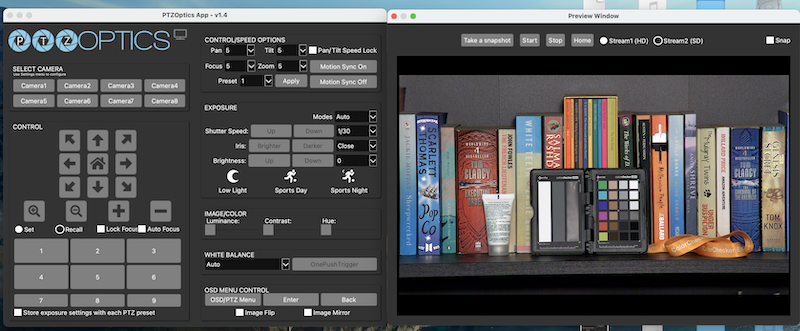
The PTZ Optics desktop app.
Once the camera is set up, you can hide settings, leaving just the camera control and video feed windows in view. It would be nice if you could adjust the size of the preview window relative to the control panel at this point. However, the window remains split 50/50 with left panel buttons simply elongating. I think greater image detail would prove far more useful than elongated buttons. One for the developers, perhaps?
A few minor bugs:
I’ve encountered a few minor bugs with the desktop app, none of which affect primary functionality. They could do with ironing out, nonetheless. These include:
- pre-set button thumbnails persisting after the pre-set is overwritten.
- pre-set button thumbnails not being generated.
- an occasional network authentication request, which can be clicked through, but is quite annoying. (PTZ Optics are aware of this and working on a solution). To be clear, the connection seems to remain rock soplid even when this message appears.
Third-party iPad app for PTZ Optics’ cameras:
The iPad app is quite basic, with, as far as I can tell, no control provided for things like exposure setting. This means that only motion control and shot pre-setting/recall are available. Up to 12 presets can be programmed for each camera, with control of up to 8 cameras available. Motion control via the onscreen joystick is very responsive. While I’ve never used a real joystick to control a camera, I’m struggling to imagine the experience being any easier.
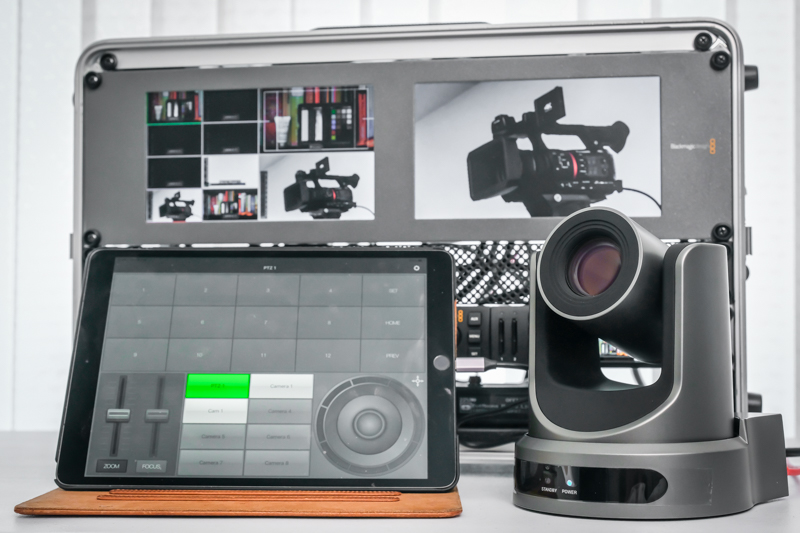
PTZ Optics iPad app. Joystick control with the iPad is a really nice experience.
Both of the apps are very good at doing different things. In theory, this means that using them in tandem could provide comprehensive, user-friendly control over the camera. However, I couldn’t find any way of connecting the two apps, meaning that pre-sets that you’ve lovingly framed, exposed, and focussed on the desktop app, can’t be addressed on an iPad! This effectively restricts you to basic motion control and auto-everything else when using the ipad app. Assuming I havent missed something, that is.
PTZ Optics 30x Image quality:
The only word I can really use here is impressive. TBH, I wasn’t expecting all that much, thinking that, in concept at least, devices like this are just glorified webcams or security cameras. How wrong I was!
I conducted a simple side-by-side test against my Panasonic AG-CX350 camcorder, which sports a well-respected lens and 1” sensor combination. I adjusted the PTZ’s exposure and colour settings to bring them as close as possible to the Pano. The method for this involved viewing the output of the cameras on two adjacent and identically set Atomos Shinobi field monitors. I also ran the output into my BMD SmartView monitors for a second opinion. Not at all scientific, but very real world, as this is the equipment I have at my disposal for calibrating cameras in the field. The output from the cameras was then switched, and then recorded on a BMD Hyperdeck Mini in pro-res. This was then imported into FCPX for viewing.
I found that side by side, image quality differences were almost entirely subjective. The images were so similar, in fact, that I repeatedly had to check which camera’s footage I was looking at in FCPX. A cropped section from a still video frame from each is shown below.
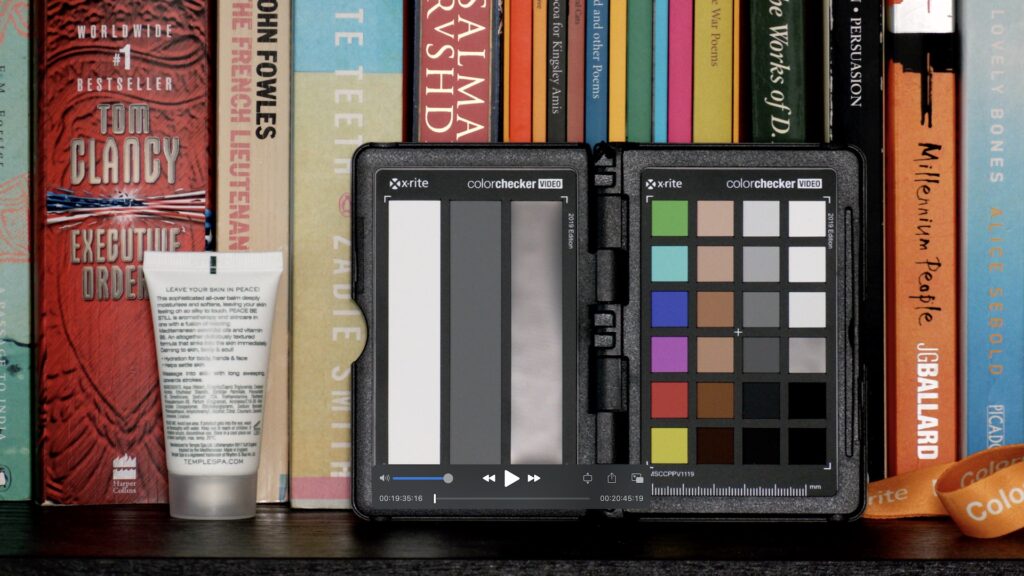
Crop from Panasonic CX350
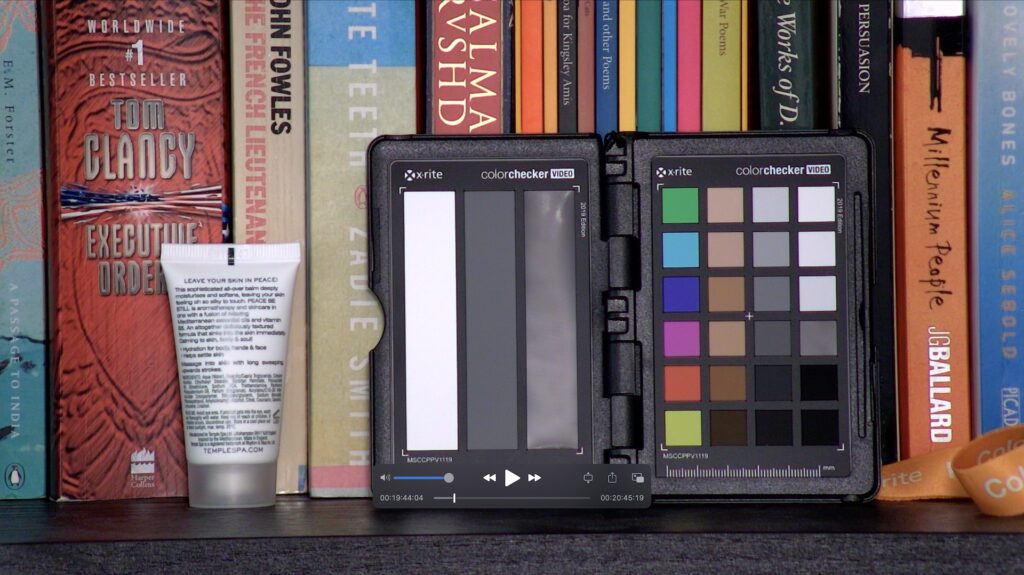
Crop from PTZ Optics 30X
If anything, to my eyes, the PTZ Optics image seems slightly sharper than the Panasonic, though colours are rendered more faithfully by the Pano. There is also slightly more evidence of noise in the dark areas of the PTZ image. I’m confident I could match the 1080p image from these two cameras very closely indeed, with more detailed in-camera adjustment.
Latency:
I measured the PTZ Optics camera output latency to be 2 frames, or 80ms at my normal 25fps streaming rate. This is really quite good for a sub £2k camera (The ubiquitous Panasonic GH5 reportedly has 7 frames of latency). In addition, video processing on my ATEM switcher adds another frame or 40ms of delay. This puts video 120ms behind the audio, resulting in quite noticeable lip-synch issues, potentially. For desktop use, embedding audio into the PTZ output is possible via the 3.5mm jack, which overcomes this problem. However, I’ll be bringing audio directly into my switcher, so I’ll need to add delay to compensate for video latency.
PTZ Optics 30x SDI 2nd generation PTZ camera in use
I’ve not yet had the opportunity to take the PTZ on a gig. However, I’ve spent several hours exploring the software and testing the camera: ‘playing’, as my other half calls it. I’ve found the camera and software combination intuitive and straightforward to use. In addition, I have no concerns whatsoever regarding either quality or reliability. I’ve also found it quite easy to integrate multiple pre-sets from one camera into my switching routine. There are definitely one or two minor bugs with the software, but I’m sure these will be fixed with future updates.
In particular, I’ve found the pre-set function very solid, with position, exposure, and focus recall all being spot on. This is a real boon for a single shooter. A little time spent in setting up this camera yields both quality and incredible versatility. With a little ancillary equipment left in situ, I could even envisage moving these cameras back and forth between venues and having a show pre-set for each.
My only real concern is that the camera feels more fragile than the large camcorder form factor that I’m more used to. This does have its plus side, however, as the unit is nice and light. Unfortunately, PTZ Optics doesn’t offer a custom case for these cameras, so I’m currently looking for something among generic products. For the moment, a padded camcorder bag with a Velcro divider will have to suffice.
Conclusion:
I’m really very excited about firing up the PTZ in anger. I’m convinced it will add significant value to my live production services, so much so that I’ve already ordered a second unit!
If you’re looking for an affordable PTZ camera for live production or video conferencing, you would be wise to check out these units from PTZ Optics. I think it very unlikely that you’ll be disappointed!
PTZ Optics 30x SDI 2nd generation PTZ camera: typically, £1800 including VAT.
Find out more about how I can support your virtual and hybrid events with my live producttion services.
Stourbridge-based Mooma Media offers event audio-visual support, event filming, live-streaming, video production, and still photography services to businesses, the public sector, and other non-commercial organisations throughout the Black Country and the wider West Midlands region. To discuss your project, or for a competitive quote click the button below.
Multi-camera live video production for virtual and hybrid events in and near:
West Midlands county: Birmingham, Solihull, Sutton Coldfield, West Bromwich, Dudley, Walsall, Wolverhampton.
Staffordshire: Lichfield, Tamworth, Stafford, Cannock,Burton upon Trent.
Shropshire: Telford, Shrewsbury, Bridgnorth, Kidderminster, Ludlow.
Worcestershire: Bromsgrove, Reditch, Droitwich, Worcester,
Warwickshire: Warwick, Stratford upon Avon, Leamington Spa, Coventry, Nuneaton,

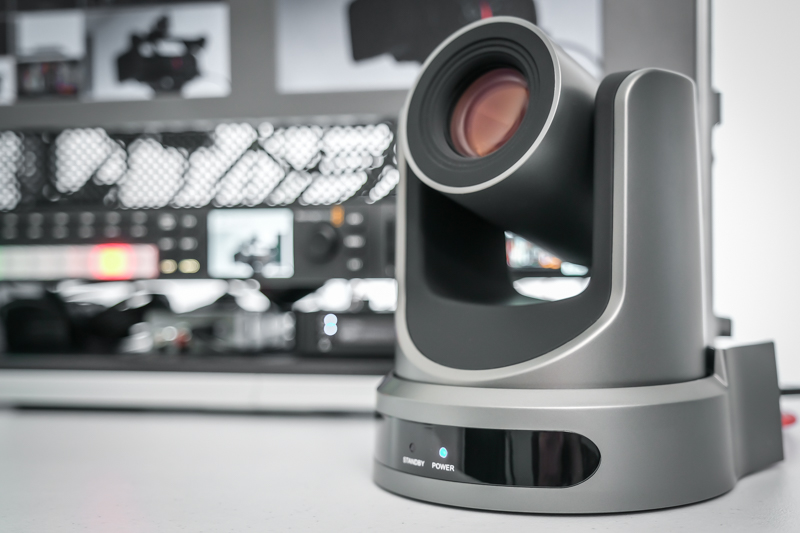
Comments are closed